Hi Food Fixers,
I am going to let you in on a secret. I am planning on proposing to my girlfriend. I want to make it a really special occasion celebrated with a fantastic meal. The thing is, my girlfriend would kill me if I proposed in a restaurant and, anyway, I want it to be just about us. I’m planning on proposing in our garden (if the weather cooperates) and sharing a celebratory glass of bubbles and a nice meal. She absolutely loves seafood so I would like that on the menu. I’m not a bad cook and I make a grand spaghetti bolognese during the week. But I know that day I will be nervous so, although I want to really impress her, I don’t want it too complicated. I only plan on proposing once so I don’t mind blowing the budget a bit on this special meal.
Looking forward to hearing your suggestions.
Tom
Wow, Tom, congratulations. This is definitely a momentous occasion and one well worth celebrating. As you likely know, food is a great way to show someone how much you love them and it sounds like you’re already pretty competent in the kitchen. I am going to share a recipe for seafood linguine which will blow the socks off your fiancée-to-be.
When it comes to seafood, less is more. A light and zesty tomato sauce, enriched with a dry white wine is the perfect accompaniment to some lightly steamed seafood. You can make the sauce in advance and even prepare the mussels beforehand. Since we’re in Ireland, I’ve included Dublin Bay Prawns in the mix (why wouldn’t you, really) in addition to the traditional mussels and scallops. You can steam the mussels directly into the sauce, while the scallops simply need a quick sear on each side before being tossed in the finished pasta.
Foccacia is a great alternative to plain old garlic bread and this version is covered in very thinly sliced garlic, potatoes and fresh rosemary. If you can, use a mandolin to slice the potato as the slices will be identical in thickness and will cook more evenly.
Best of luck with the proposal and the recipes.
Seafood linguine with a tomato & white wine sauce
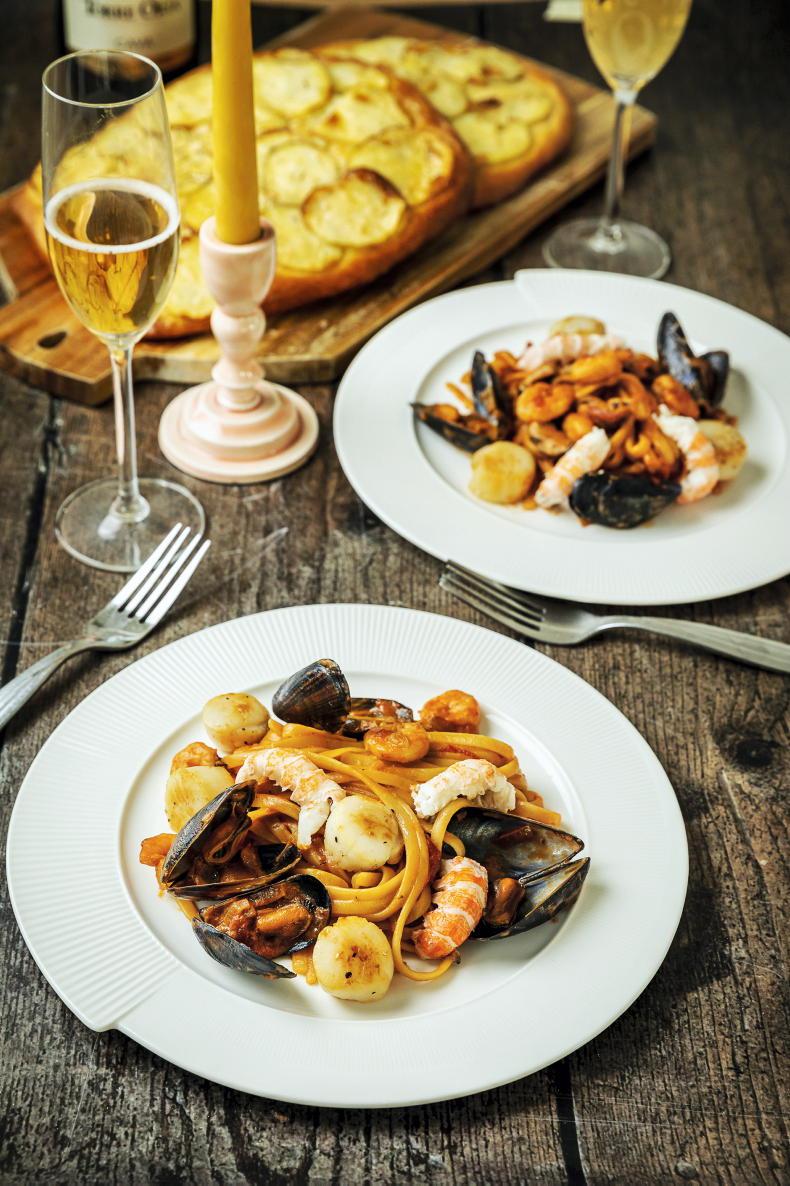
Summer Food Mag -Engagement Meal of Linguine with Foccacia
serves two
200g dried linguine pasta
500g mussels
6-8 scallops
4-6 langoustines (Dublin bay prawns) lightly steamed
1/4 bunch flat leaf parsley, finely chopped
Rapeseed oil, for drizzling
For the tomato and white wine sauce:
1 medium onion, finely diced
1 tbsp rapeseed oil
2 cloves garlic, finely chopped
1 tsp red chilli flakes
1 tsp dried oregano
1 tbsp tomato puree
Zest of one lemon
200ml dry white wine
400g tinned, chopped tomatoes
400ml hot chicken or vegetable stock
1/2 bunch fresh basil kept whole
Salt and pepper, to taste
1 Make the tomato and white wine sauce (can be made up to two days before). In a large skillet or saucepan, heat the olive or rapeseed oil on medium-high heat and add the diced onion. Cook the onion until completely cooked through and translucent (about eight to 10 minutes), stirring occasionally.
2 Add the garlic, chilli flakes, oregano and lemon zest. Stir to combine and gently cook for an additional two to three minutes.
3 Add the tomato puree and stir into the onion mixture until it’s well-combined. Cook the tomato puree for around one to two minutes and then add the white wine.
4 Simmer this mixture until the wine is evaporated by around half. Add the tinned tomatoes, vegetable or chicken stock and the half-bunch of basil (just add the whole thing in, stalks and all).
5 Cover and simmer on low for at least an hour but up to three hours. Remove the lid and cook for an additional hour until most of the liquid is evaporated and it has developed a thicker sauce consistency. Season to taste.
6 Cool and store in the fridge until ready to use or use immediately. Remove the basil stalks (they will have flavoured the sauce at this stage) and discard them.
7 Prepare the seafood. In a very hot pan, sear the scallops to give a nice colour on both sides. Scrub the mussels; discarding any that appear broken or are open and do not close when pressed together. Remove the “beard” on the mussels (the rough mossy material found on the hinge) and set aside to use immediately. Alternatively, you can keep them in the fridge on a bed of ice for up to 24 hours until ready to use.
8 Steam the langoustines in some simmering water or white wine with a slice of lemon for five minutes. Twist the bodies to remove the heads from the tails, then remove the tail meat by squeezing the two sides of the tail together until the shell cracks. Retain the tail meat for the pasta (you can freeze the shells to make sauce or fish stock at a later time).
9 Bring a pot of salted water to a rapid boil and cook the linguine as per package instructions. When the pasta is cooked, strain and toss it, while hot, in a bit of rapeseed oil so it doesn’t stick together.
10 Bring the tomato sauce back to a simmer and add in the mussels. Cover with a tight- fitting lid and let them steam for up to five minutes. They’re cooked when the shells are wide open. Add in the langoustine tails and the scallops; toss them through the sauce just to warm them up - you don’t want to overcook them.
11 Add in the cooked pasta and toss until everything is coated in the sauce. Add in freshly chopped parsley and serve immediately. Finish with a little drizzle of good quality rapeseed or olive oil and serve with potato foccacia.
Note: as a general rule, do not use Parmesan cheese on a seafood pasta. Parsley, fresh basil or more chilli flakes are fine, though.
Potato and garlic foccacia
serves two to four
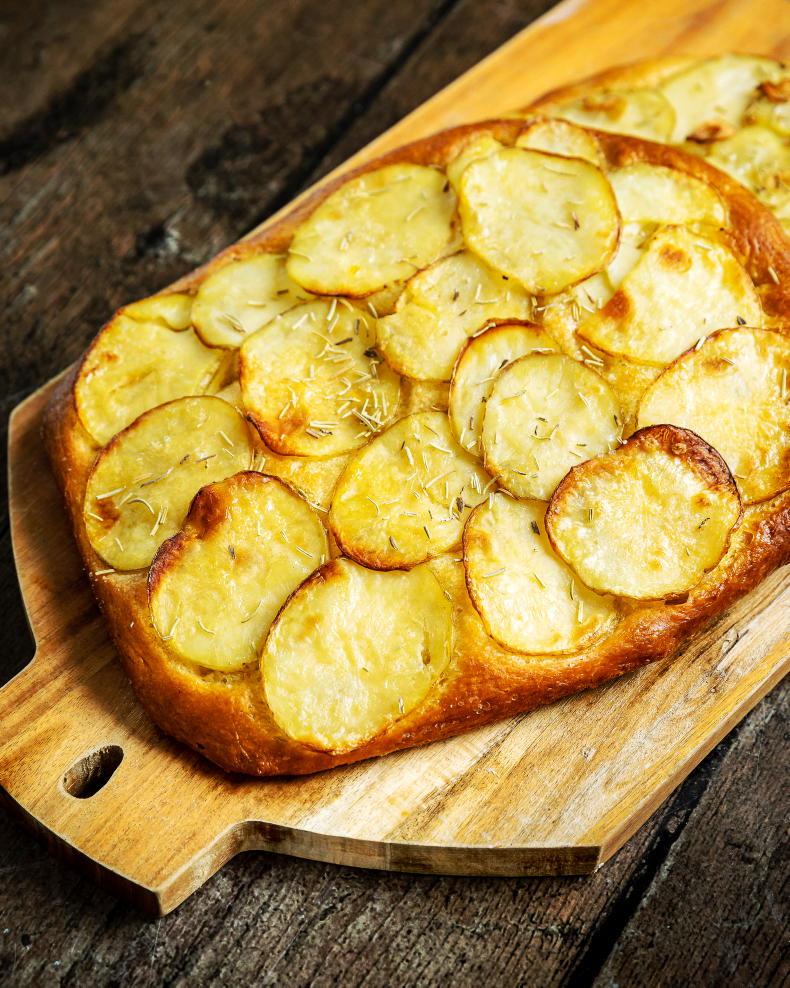
Summer Food Mag -Engagement Meal of Linguine with Foccacia
200g bread flour
150ml warm water
1 packet (12g) dry active yeast
1 tbsp honey
2 tsp salt
2 medium-sized potatoes, thinly sliced (use a mandolin for best results)
2 sprigs fresh rosemary
4 cloves garlic, thinly sliced
2 tbsp Irish rapeseed oil (plus more for drizzling)
Flaky sea salt
1 In a bowl, add the yeast and honey. Pour half the warm water over the top and let it sit for around 10 minutes, until the yeast is bubbly and active.
2 Add the remaining water, the bread (strong) flour, 2 tbsp oil and 2 tsp salt. Mix with your hands until a dough comes together. It will be sticky (this is normal for foccacia).
3 Knead in the bowl or on a lightly floured surface until the dough is smooth and elastic; about 10 minutes. Add the dough back into the bowl and let it rise for one hour at room temperature.
4 Punch the dough down and reshape into a ball. Cover and refrigerate overnight.
5 The next day, bring a saucepan of water to a boil and add in the sliced potato. Cook for five to 10 minutes, until tender. Strain, spread the potato slices out on a large platter and drizzle with a bit of oil so they don’t get sticky.
6 Punch down your dough and gently spread it out onto a baking sheet or tray. I turn the oven light on at this stage (or if your oven has a proving function, turn it on) and leave the tray in the warm oven to prove for another hour.
7 Using your fingers, poke holes in the dough all over the surface (this encourages even baking). Drizzle with oil, add a layer of potato slices, the sliced garlic and bits of fresh rosemary, then generously sprinkle on flaky sea salt. I leave it out at room temperature while preheating the oven to 200°C.
8 Bake the foccacia until it’s nicely browned on top and completely cooked through. Let it cool on a wire rack and eat immediately.
Tom, big congrats. I love that your query has allowed me to knock your socks off with some lovely suggestions. Whenever I select wines for our pages, I am always conscious of people’s budgets. But we all deserve a treat – especially for a special occasion like this – and this is often an area readers want guidance on.
So let’s pop the bubbly. I’ve selected two champagnes for your special occasion. Let’s be honest. Part of champagne’s price tag is derived from the fact that it is a massive international marketing sensation. However, that’s just part of the story.
In order for a bottle to carry the word champagne, it must be produced in the Champagne region and be made in a very specific way, “méthode champenoise”. Fermentation takes place in the bottle and it must mature for a minimum of 15 months, making it very labour intensive and costly, which is why champagne is expensive.
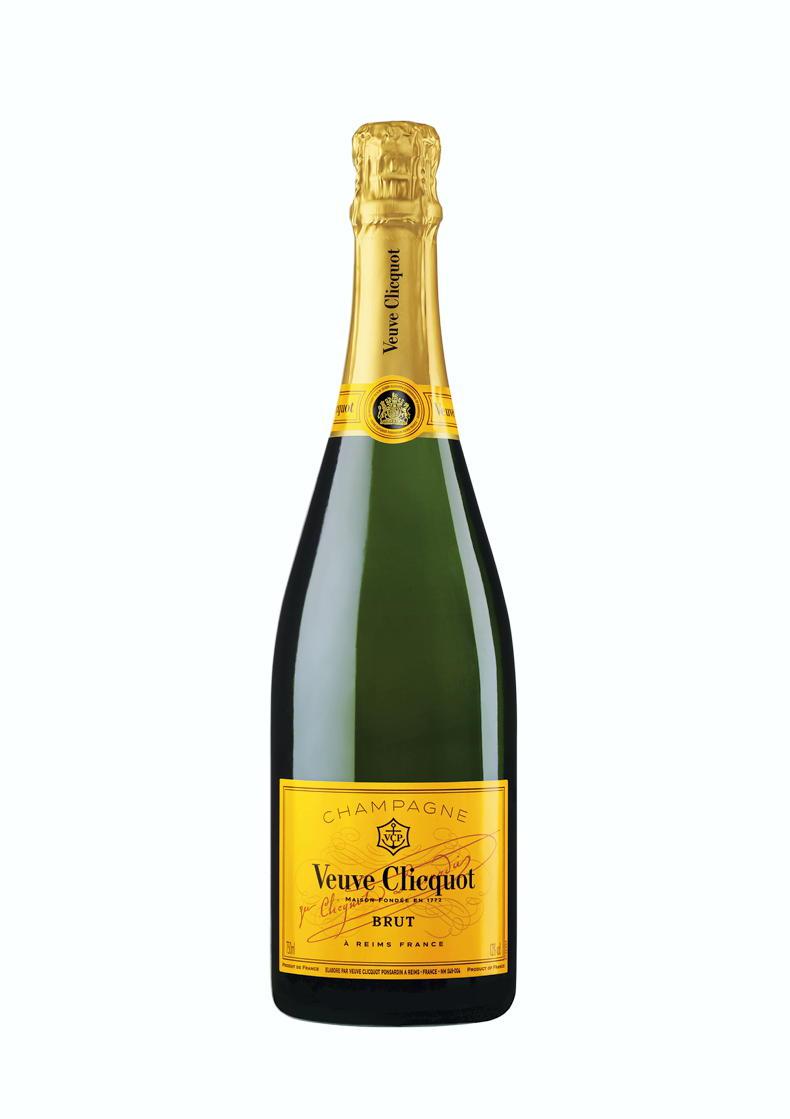
There are some champagne houses that have perfected the art. Veuve Clicquot is among the original and the best. In fact, in 1816 it was Veuve Cliquot herself who perfected the riddling rack (a delicate bottle turn which ensures there is never sediment in champagne), which is still used today by champagne makers. Veuve Clicquot Yellow Label is its signature style, which has beautiful beads of golden bubbles. It’s fabulously fresh with fruity flavours of peach and pear complemented by a little vanilla and complete with that signature toasty brioche notes of a good champagne. The reason I’ve picked this bottle is it is also excellent when paired with both pasta and seafood so after your celebratory drink this bottle will carry you right through your meal. Priced at €64.45, it is available from most independent off-licences, including O’Briens, The Corkscrew, The Winehouse, World Wide Wines, The Wine Centre, Molloy’s, On The Grapevine, Redmond’s & Celtic Whiskey Store and nationwide in Brown Thomas.

I love a good pop of pink for a celebration and let’s stick with another one of the famous champagne houses, Tattinger. Their Prestige Rosé (picture two) has this beautiful pinkish-red hue, perfect for an engagement celebration. Interestingly, this champagne has a high proportion of chardonnay which leads to a fresh, crisp fruit presence. You’ll get pops of crushed wild raspberries and cherries, which is then complemented by a full-bodied velvety texture. It has a powerfully long finish which will make you want to savour every sip of the moment. This champagne is usually €80 but it’s on special offer for €60 in O’Brien’s Wines until the end of August.
For dinner, I’ve opted for a rosé and a white to complement the meal. A lot of people have heard of Whispering Angel, which is an excellent wine. But, hey, it’s your engagement so let’s step things up a notch with its big sister Rock Angel (picture three). They are produced in the same winery, Château d’Esclans in Provence, home of some of the best rosé wines in the world.

However, Rock Angel earns its big sister badge (and accompanying price tag) due to a partial fermentation in oak casks. But oh does it elevate the complexity of the wine. You still get those summer strawberries fruits with a hint of spice and the refreshing salinity but that comes with a mouthfeel which is structured, crisp yet creamy making it an excellent food wine that will pair fantastic with your seafood pasta. Rock Angel is €42 and is available from the independent off-licences listed above.
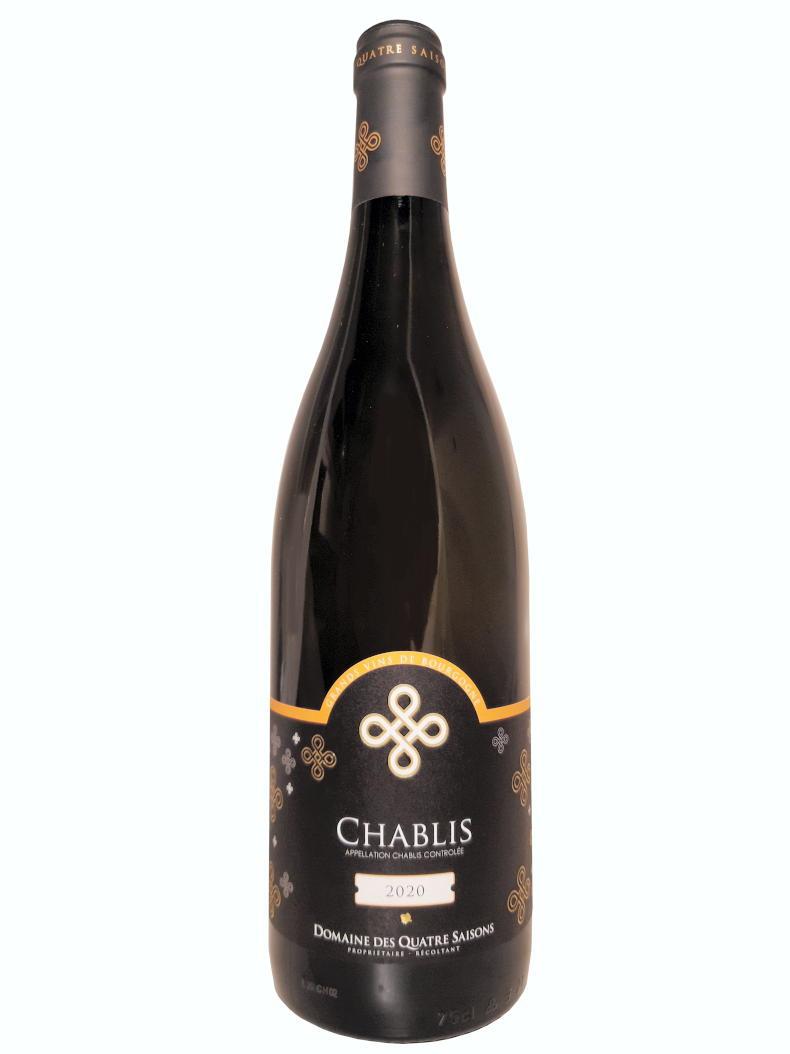
If you’re more partial to a drop of white, a good Chablis is a great choice. Chardonnay can carry a more richly flavoured shellfish meal like the one Janine has suggested. This Domaine de Quatre Saisons is €21 in Dunnes Stores and has all the notes of a good Chablis-fruit forward flavours of apples, pears and peach with a rounded minerality and good acidity. Finished off with a buttery long finish, this is a natural fit for your meal. Enjoy the celebrations.
Hi Food Fixers,
I am going to let you in on a secret. I am planning on proposing to my girlfriend. I want to make it a really special occasion celebrated with a fantastic meal. The thing is, my girlfriend would kill me if I proposed in a restaurant and, anyway, I want it to be just about us. I’m planning on proposing in our garden (if the weather cooperates) and sharing a celebratory glass of bubbles and a nice meal. She absolutely loves seafood so I would like that on the menu. I’m not a bad cook and I make a grand spaghetti bolognese during the week. But I know that day I will be nervous so, although I want to really impress her, I don’t want it too complicated. I only plan on proposing once so I don’t mind blowing the budget a bit on this special meal.
Looking forward to hearing your suggestions.
Tom
Wow, Tom, congratulations. This is definitely a momentous occasion and one well worth celebrating. As you likely know, food is a great way to show someone how much you love them and it sounds like you’re already pretty competent in the kitchen. I am going to share a recipe for seafood linguine which will blow the socks off your fiancée-to-be.
When it comes to seafood, less is more. A light and zesty tomato sauce, enriched with a dry white wine is the perfect accompaniment to some lightly steamed seafood. You can make the sauce in advance and even prepare the mussels beforehand. Since we’re in Ireland, I’ve included Dublin Bay Prawns in the mix (why wouldn’t you, really) in addition to the traditional mussels and scallops. You can steam the mussels directly into the sauce, while the scallops simply need a quick sear on each side before being tossed in the finished pasta.
Foccacia is a great alternative to plain old garlic bread and this version is covered in very thinly sliced garlic, potatoes and fresh rosemary. If you can, use a mandolin to slice the potato as the slices will be identical in thickness and will cook more evenly.
Best of luck with the proposal and the recipes.
Seafood linguine with a tomato & white wine sauce

Summer Food Mag -Engagement Meal of Linguine with Foccacia
serves two
200g dried linguine pasta
500g mussels
6-8 scallops
4-6 langoustines (Dublin bay prawns) lightly steamed
1/4 bunch flat leaf parsley, finely chopped
Rapeseed oil, for drizzling
For the tomato and white wine sauce:
1 medium onion, finely diced
1 tbsp rapeseed oil
2 cloves garlic, finely chopped
1 tsp red chilli flakes
1 tsp dried oregano
1 tbsp tomato puree
Zest of one lemon
200ml dry white wine
400g tinned, chopped tomatoes
400ml hot chicken or vegetable stock
1/2 bunch fresh basil kept whole
Salt and pepper, to taste
1 Make the tomato and white wine sauce (can be made up to two days before). In a large skillet or saucepan, heat the olive or rapeseed oil on medium-high heat and add the diced onion. Cook the onion until completely cooked through and translucent (about eight to 10 minutes), stirring occasionally.
2 Add the garlic, chilli flakes, oregano and lemon zest. Stir to combine and gently cook for an additional two to three minutes.
3 Add the tomato puree and stir into the onion mixture until it’s well-combined. Cook the tomato puree for around one to two minutes and then add the white wine.
4 Simmer this mixture until the wine is evaporated by around half. Add the tinned tomatoes, vegetable or chicken stock and the half-bunch of basil (just add the whole thing in, stalks and all).
5 Cover and simmer on low for at least an hour but up to three hours. Remove the lid and cook for an additional hour until most of the liquid is evaporated and it has developed a thicker sauce consistency. Season to taste.
6 Cool and store in the fridge until ready to use or use immediately. Remove the basil stalks (they will have flavoured the sauce at this stage) and discard them.
7 Prepare the seafood. In a very hot pan, sear the scallops to give a nice colour on both sides. Scrub the mussels; discarding any that appear broken or are open and do not close when pressed together. Remove the “beard” on the mussels (the rough mossy material found on the hinge) and set aside to use immediately. Alternatively, you can keep them in the fridge on a bed of ice for up to 24 hours until ready to use.
8 Steam the langoustines in some simmering water or white wine with a slice of lemon for five minutes. Twist the bodies to remove the heads from the tails, then remove the tail meat by squeezing the two sides of the tail together until the shell cracks. Retain the tail meat for the pasta (you can freeze the shells to make sauce or fish stock at a later time).
9 Bring a pot of salted water to a rapid boil and cook the linguine as per package instructions. When the pasta is cooked, strain and toss it, while hot, in a bit of rapeseed oil so it doesn’t stick together.
10 Bring the tomato sauce back to a simmer and add in the mussels. Cover with a tight- fitting lid and let them steam for up to five minutes. They’re cooked when the shells are wide open. Add in the langoustine tails and the scallops; toss them through the sauce just to warm them up - you don’t want to overcook them.
11 Add in the cooked pasta and toss until everything is coated in the sauce. Add in freshly chopped parsley and serve immediately. Finish with a little drizzle of good quality rapeseed or olive oil and serve with potato foccacia.
Note: as a general rule, do not use Parmesan cheese on a seafood pasta. Parsley, fresh basil or more chilli flakes are fine, though.
Potato and garlic foccacia
serves two to four

Summer Food Mag -Engagement Meal of Linguine with Foccacia
200g bread flour
150ml warm water
1 packet (12g) dry active yeast
1 tbsp honey
2 tsp salt
2 medium-sized potatoes, thinly sliced (use a mandolin for best results)
2 sprigs fresh rosemary
4 cloves garlic, thinly sliced
2 tbsp Irish rapeseed oil (plus more for drizzling)
Flaky sea salt
1 In a bowl, add the yeast and honey. Pour half the warm water over the top and let it sit for around 10 minutes, until the yeast is bubbly and active.
2 Add the remaining water, the bread (strong) flour, 2 tbsp oil and 2 tsp salt. Mix with your hands until a dough comes together. It will be sticky (this is normal for foccacia).
3 Knead in the bowl or on a lightly floured surface until the dough is smooth and elastic; about 10 minutes. Add the dough back into the bowl and let it rise for one hour at room temperature.
4 Punch the dough down and reshape into a ball. Cover and refrigerate overnight.
5 The next day, bring a saucepan of water to a boil and add in the sliced potato. Cook for five to 10 minutes, until tender. Strain, spread the potato slices out on a large platter and drizzle with a bit of oil so they don’t get sticky.
6 Punch down your dough and gently spread it out onto a baking sheet or tray. I turn the oven light on at this stage (or if your oven has a proving function, turn it on) and leave the tray in the warm oven to prove for another hour.
7 Using your fingers, poke holes in the dough all over the surface (this encourages even baking). Drizzle with oil, add a layer of potato slices, the sliced garlic and bits of fresh rosemary, then generously sprinkle on flaky sea salt. I leave it out at room temperature while preheating the oven to 200°C.
8 Bake the foccacia until it’s nicely browned on top and completely cooked through. Let it cool on a wire rack and eat immediately.
Tom, big congrats. I love that your query has allowed me to knock your socks off with some lovely suggestions. Whenever I select wines for our pages, I am always conscious of people’s budgets. But we all deserve a treat – especially for a special occasion like this – and this is often an area readers want guidance on.
So let’s pop the bubbly. I’ve selected two champagnes for your special occasion. Let’s be honest. Part of champagne’s price tag is derived from the fact that it is a massive international marketing sensation. However, that’s just part of the story.
In order for a bottle to carry the word champagne, it must be produced in the Champagne region and be made in a very specific way, “méthode champenoise”. Fermentation takes place in the bottle and it must mature for a minimum of 15 months, making it very labour intensive and costly, which is why champagne is expensive.

There are some champagne houses that have perfected the art. Veuve Clicquot is among the original and the best. In fact, in 1816 it was Veuve Cliquot herself who perfected the riddling rack (a delicate bottle turn which ensures there is never sediment in champagne), which is still used today by champagne makers. Veuve Clicquot Yellow Label is its signature style, which has beautiful beads of golden bubbles. It’s fabulously fresh with fruity flavours of peach and pear complemented by a little vanilla and complete with that signature toasty brioche notes of a good champagne. The reason I’ve picked this bottle is it is also excellent when paired with both pasta and seafood so after your celebratory drink this bottle will carry you right through your meal. Priced at €64.45, it is available from most independent off-licences, including O’Briens, The Corkscrew, The Winehouse, World Wide Wines, The Wine Centre, Molloy’s, On The Grapevine, Redmond’s & Celtic Whiskey Store and nationwide in Brown Thomas.

I love a good pop of pink for a celebration and let’s stick with another one of the famous champagne houses, Tattinger. Their Prestige Rosé (picture two) has this beautiful pinkish-red hue, perfect for an engagement celebration. Interestingly, this champagne has a high proportion of chardonnay which leads to a fresh, crisp fruit presence. You’ll get pops of crushed wild raspberries and cherries, which is then complemented by a full-bodied velvety texture. It has a powerfully long finish which will make you want to savour every sip of the moment. This champagne is usually €80 but it’s on special offer for €60 in O’Brien’s Wines until the end of August.
For dinner, I’ve opted for a rosé and a white to complement the meal. A lot of people have heard of Whispering Angel, which is an excellent wine. But, hey, it’s your engagement so let’s step things up a notch with its big sister Rock Angel (picture three). They are produced in the same winery, Château d’Esclans in Provence, home of some of the best rosé wines in the world.

However, Rock Angel earns its big sister badge (and accompanying price tag) due to a partial fermentation in oak casks. But oh does it elevate the complexity of the wine. You still get those summer strawberries fruits with a hint of spice and the refreshing salinity but that comes with a mouthfeel which is structured, crisp yet creamy making it an excellent food wine that will pair fantastic with your seafood pasta. Rock Angel is €42 and is available from the independent off-licences listed above.

If you’re more partial to a drop of white, a good Chablis is a great choice. Chardonnay can carry a more richly flavoured shellfish meal like the one Janine has suggested. This Domaine de Quatre Saisons is €21 in Dunnes Stores and has all the notes of a good Chablis-fruit forward flavours of apples, pears and peach with a rounded minerality and good acidity. Finished off with a buttery long finish, this is a natural fit for your meal. Enjoy the celebrations.











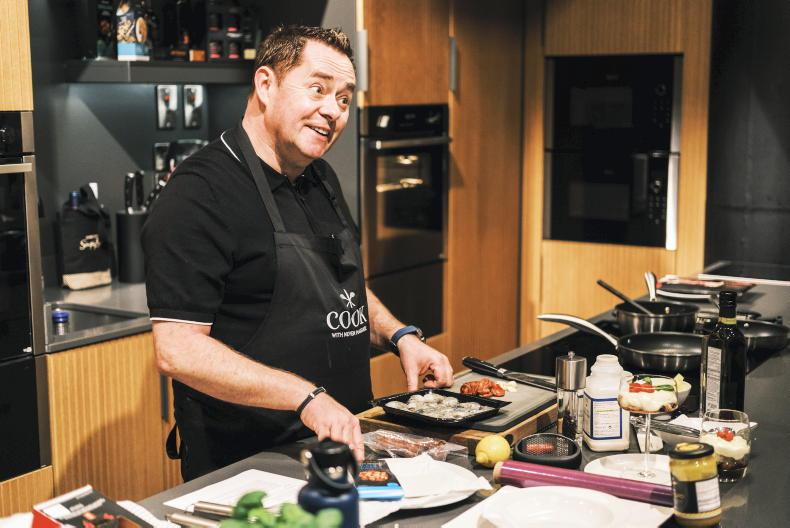
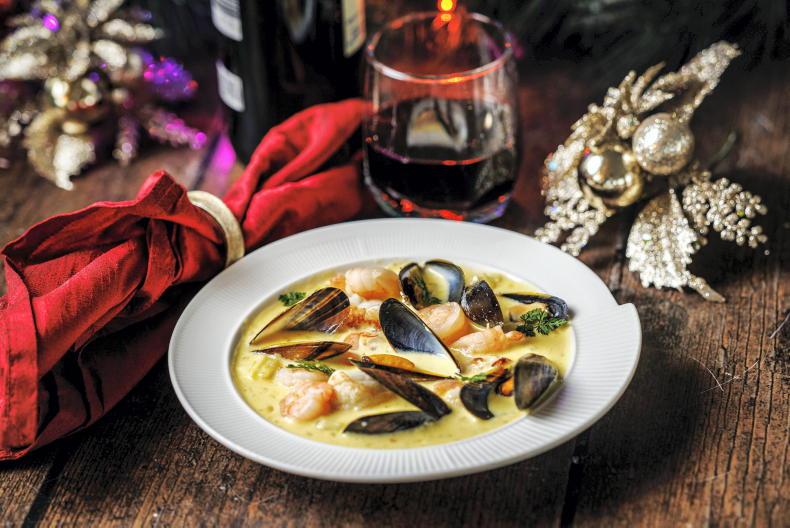
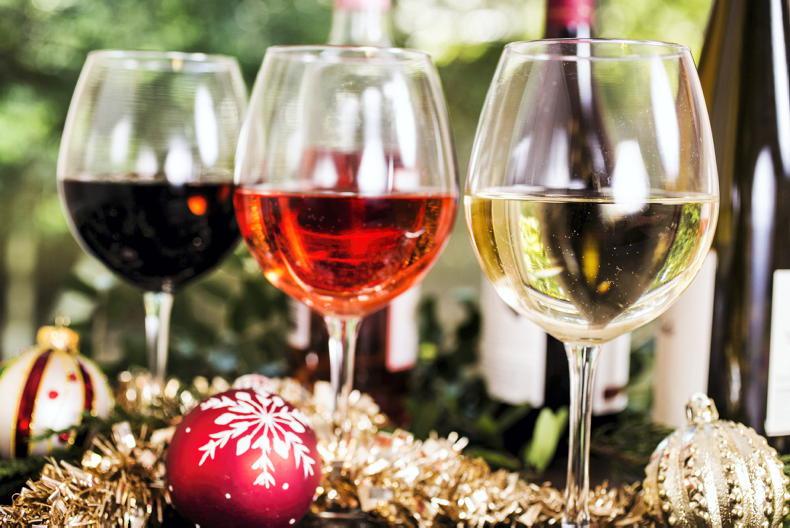

SHARING OPTIONS